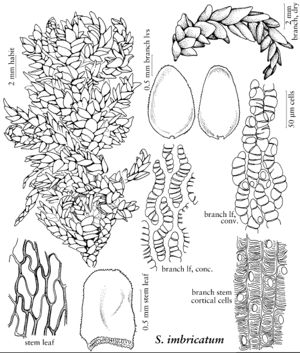Difference between revisions of "Sphagnum imbricatum"
Beitr. Torfm., 99. 1865,.
FNA>Volume Importer |
FNA>Volume Importer |
(No difference)
| |
Revision as of 21:50, 16 December 2019
Plants moderate-sized, weak-stemmed, lax; yellowish to golden brown; forming loose carpets; branches loosely imbricate. Stems yellow to brown, superficial cortical layer with spiral reinforcing fibrils visible, 1 or more pores/cell, comb-fibrils on interior wall. Stem leaves short-rectangular, 0.8–1.1 mm, hyaline cells mostly non-septate and absent comb-fibrils. Branch fascicles with 2 spreading and 1–2 hanging branches. Branch stems with hyaline cells non-ornamented, no or weak funnel-like projections on the end walls of cortical cells, cortical cell walls usually with large round pores. Branch leaves ovate to ovate-elliptic, 1.4–1.8 mm; hyaline cells on convex surface with numerous pores along the commissures; comb-lamellae obvious only in proximal 1/2 of leaf; chlorophyllous cells broadly triangular in transverse section and well-enclosed on the convex surface. Sexual condition dioecious. Spores (22) 24–27(–28) µm, surface granulate.
Habitat: Ecology poorly known
Elevation: moderate elevations
Distribution
Alaska.
Discussion
K. I. Flatberg (1984) considered Sphagnum imbricatum to be East Asian in distribution but a recent collection in Selawik National Wildlife Refuge places it in the North American flora. It will undoubtedly be found elsewhere. Sphagnum imbricatum is closest in morphological detail to S. steerei, but the latter is a very dark colored and densely branched species whereas S. imbricatum is quite light in color and not particularly dense.
Selected References
None.
